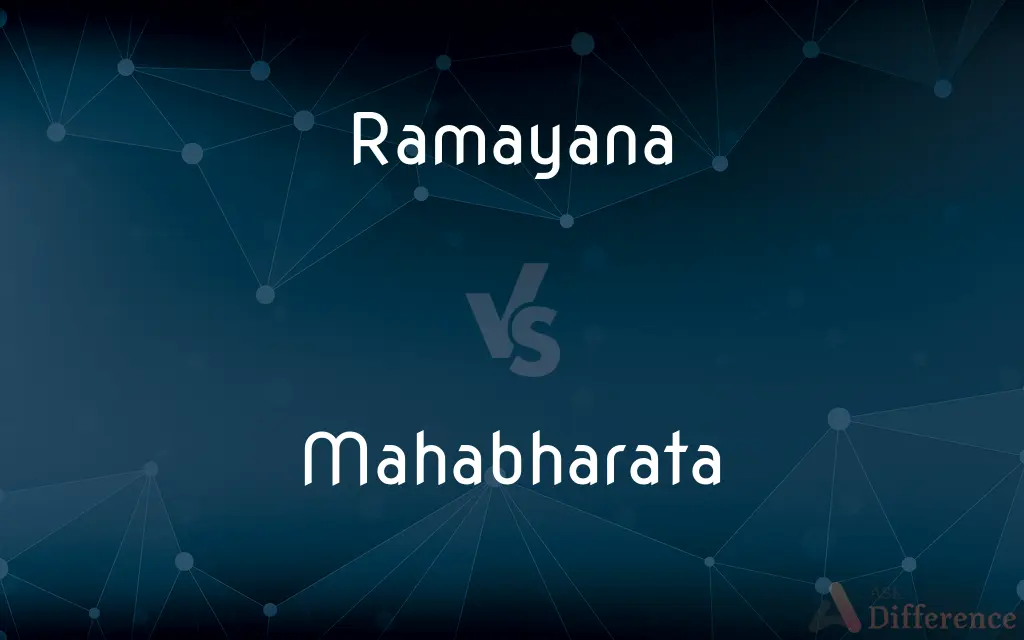Ramayana vs. Mahabharata — What's the Difference?
By Fiza Rafique & Urooj Arif — Updated on March 13, 2024
The Ramayana focuses on the life of Rama, emphasizing dharma and righteousness, while the Mahabharata showcases a complex war, highlighting themes of morality and justice.

Difference Between Ramayana and Mahabharata
Table of Contents
ADVERTISEMENT
Key Differences
The Ramayana and Mahabharata are two epic sagas deeply ingrained in the cultural and religious fabric of India, revered for their profound spiritual and moral teachings. The Ramayana, attributed to the sage Valmiki, narrates the story of Lord Rama, his wife Sita, and his loyal companion Hanuman, emphasizing the virtues of dharma (duty/righteousness) and the triumph of good over evil. On the other hand, the Mahabharata, attributed to Vyasa, is an intricate tale of the dynastic struggle between the Pandavas and the Kauravas, culminating in the epic battle of Kurukshetra. It delves into complex questions of morality, duty, and the impermanence of life, famously encapsulated in the Bhagavad Gita.
The Ramayana is structured around Rama's quest to rescue his wife Sita from the demon king Ravana, showcasing his adherence to dharma despite numerous trials and tribulations. In contrast, the Mahabharata presents a more complex narrative of familial feud, political intrigue, and the moral dilemmas faced by its characters, especially Arjuna, leading to a devastating war that involves a vast array of characters from the Indian pantheon. This contrast reflects the different thematic focuses of the two epics: personal righteousness and the duties of the individual versus the complexities of moral decisions in a broader societal context.
The characters of the Ramayana are often idealized figures embodying virtues to be emulated, such as Rama's unwavering commitment to truth and Sita's devotion and purity. Whereas, the characters in the Mahabharata are depicted with more nuanced personalities and moral complexities, such as Arjuna's initial reluctance to fight his kin and Krishna's strategic counsel that sometimes involves deceit for the greater good. This portrayal underlines the epics' differing approaches to conveying ethical and moral lessons through their narratives.
While the Ramayana is primarily centered around the concept of ideal behavior and relationships, such as the ideal king, spouse, and servant, the Mahabharata explores the reality of human nature and the inevitable conflicts that arise from it. It portrays a more realistic view of life, where dharma is ambiguous, and decisions often result in unintended consequences, reflecting the complexities of real-world moral dilemmas.
In terms of influence, both epics have profoundly impacted Indian culture, religion, and philosophy, inspiring countless adaptations, performances, and teachings across centuries. However, the Ramayana is often seen as a guide to personal conduct and the importance of adhering to one's duties, while the Mahabharata is viewed as a more comprehensive exploration of ethics, governance, and human psychology within the framework of an extensive narrative.
ADVERTISEMENT
Comparison Chart
Author
Valmiki
Vyasa
Focus
The virtues of dharma and righteousness
Complex questions of morality and justice
Main Character
Rama, an avatar of Vishnu
The Pandavas and Kauravas, and Lord Krishna
Theme
Ideal behavior and relationships
The complexities of moral dilemmas
Influence
Personal conduct and adherence to duty
Ethics, governance, and human psychology
Compare with Definitions
Ramayana
An ancient Indian epic narrating Lord Rama's life, emphasizing ideals of dharma.
The Ramayana teaches the importance of righteousness and moral values.
Mahabharata
The longest epic poem in the world, detailing the Kurukshetra war and moral dilemmas faced by its characters.
The Mahabharata's Bhagavad Gita offers philosophical guidance on duty and righteousness.
Ramayana
A tale of the triumph of good over evil, through Rama's victory over Ravana.
The Ramayana is celebrated in the festival of Diwali, symbolizing the victory of light over darkness.
Mahabharata
A foundational work influencing Indian thought, spirituality, and culture.
The philosophical teachings of the Mahabharata have shaped Indian ethical and spiritual outlooks.
Ramayana
A story that highlights the roles of ideal characters, such as the ideal king (Rama), wife (Sita), and devotee (Hanuman).
In the Ramayana, Sita's unwavering fidelity and purity are central themes.
Mahabharata
An epic that offers insights into governance, justice, and ethics, through its vast array of characters and stories.
Krishna's counsel in the Mahabharata provides timeless wisdom on leadership and morality.
Ramayana
An epic that has significantly influenced Indian culture, art, and morality.
The Ramayana's impact is evident in various cultural expressions across India, from dance dramas to temple architecture.
Mahabharata
A text that delves deep into the complexities of human nature and the ambiguity of dharma.
The Mahabharata portrays the struggle to discern right action in morally complex situations.
Ramayana
A narrative that explores themes of loyalty, bravery, and the power of righteousness.
Hanuman's devotion in the Ramayana exemplifies the strength of true loyalty and love.
Mahabharata
An intricate story of familial feud, ambition, and the quest for power, culminating in a devastating war.
The conflict between the Pandavas and the Kauravas in the Mahabharata underscores the tragic consequences of greed and enmity.
Ramayana
Rāmāyana (; Sanskrit: रामायणम्, IAST: Rāmāyaṇam pronounced [raːˈmaːjɐɳɐm]) is one of the two major Sanskrit epics of ancient India and important text of Hinduism, the other being the Mahābhārata.The epic, traditionally ascribed to the Maharishi Valmiki, narrates the life of Rama, a legendary prince of Ayodhya city in the kingdom of Kosala. The epic follows his fourteen-year exile to the forest urged by his father King Dasharatha, on the request of Rama's stepmother Kaikeyi; his travels across forests in the Indian subcontinent with his wife Sita and brother Lakshmana, the kidnapping of Sita by Ravana – the king of Lanka, that resulted in war; and Rama's eventual return to Ayodhya to be crowned king amidst jubilation and celebration.
Mahabharata
The Mahābhārata (US: , UK: ; Sanskrit: महाभारतम्, Mahābhāratam, pronounced [mɐɦaːˈbʱaːɾɐtɐm]) is one of the two major Sanskrit epics of ancient India, the other being the Rāmāyaṇa. It narrates the struggle between two groups of cousins in the Kurukshetra War and the fates of the Kaurava and the Pāṇḍava princes and their successors.
Ramayana
A Sanskrit epic, traditionally attributed to Valmiki, that concerns the banishment of Rama from his kingdom, the abduction of his wife Sita by a demon and her rescue, and Rama's eventual restoration to the throne.
Mahabharata
A Sanskrit epic principally concerning the dynastic struggle and civil war between the Pandavas and the Kauravas in the kingdom of Kurukshetra about the 9th century BC, and containing the text of the Bhagavad-Gita, numerous subplots, and interpolations on theology, morals, and statecraft.
Ramayana
The more ancient of the two great epic poems in Sanskrit. The hero and heroine are Rama and his wife Sita.
Mahabharata
(Hinduism) a sacred epic Sanskrit poem of India dealing in many episodes with the struggle between two rival families
Ramayana
One of two classical Hindu epics telling of the banishment of Rama from his kingdom and the abduction of his wife by a demon and Rama's restoration to the throne
Common Curiosities
What is the main focus of the Ramayana?
The Ramayana focuses on Rama's quest to rescue his wife and emphasizes the virtues of dharma.
Who authored the Ramayana and Mahabharata?
The Ramayana is attributed to Valmiki, and the Mahabharata to Vyasa.
How do the characters in the Ramayana and Mahabharata differ?
The Ramayana's characters are idealized figures embodying virtues, whereas the Mahabharata's characters are portrayed with more nuanced and complex personalities.
What are the Ramayana and Mahabharata?
The Ramayana and Mahabharata are ancient Indian epics, revered for their moral and philosophical teachings.
What central theme does the Mahabharata explore?
The Mahabharata explores the complexities of moral dilemmas and the nature of dharma.
How do the endings of the Ramayana and Mahabharata differ?
The Ramayana ends with Rama's righteous rule, symbolizing the triumph of good, while the Mahabharata concludes with a more somber reflection on the war's devastation and the fleeting nature of life.
Can the Ramayana and Mahabharata be considered historical texts?
While they contain historical elements, they are primarily viewed as mythological and spiritual texts.
What is the significance of the Bhagavad Gita in the Mahabharata?
The Bhagavad Gita is a philosophical discourse on duty, righteousness, and the nature of the soul, set in the context of the Kurukshetra war.
What are the key differences in the portrayal of heroes in both epics?
The Ramayana's heroes are more straightforwardly virtuous, while the Mahabharata's heroes are complex and flawed.
How are the themes of justice and morality explored in both epics?
Through narrative and characters' dilemmas, both epics explore themes of justice and morality, albeit in different contexts and with different outcomes.
How is dharma portrayed in the Ramayana and Mahabharata?
Dharma in the Ramayana is about righteous living and loyalty, while in the Mahabharata, it deals with the moral complexities of life.
What role do the gods play in these epics?
Gods play pivotal roles, guiding characters and influencing events, symbolizing divine intervention in human affairs.
How have the Ramayana and Mahabharata influenced Indian culture?
They have deeply influenced Indian art, culture, philosophy, and religious practices.
Are the teachings of the Ramayana and Mahabharata relevant today?
Yes, their teachings on morality, duty, and the complexities of human nature remain relevant.
What lessons can be learned from the Ramayana and Mahabharata?
Lessons on duty, morality, the importance of righteousness, and the complexities of ethical decision-making can be learned.
Share Your Discovery

Previous Comparison
Had vs. Have
Next Comparison
Worldwide vs. InternationalAuthor Spotlight
Written by
Fiza RafiqueFiza Rafique is a skilled content writer at AskDifference.com, where she meticulously refines and enhances written pieces. Drawing from her vast editorial expertise, Fiza ensures clarity, accuracy, and precision in every article. Passionate about language, she continually seeks to elevate the quality of content for readers worldwide.
Co-written by
Urooj ArifUrooj is a skilled content writer at Ask Difference, known for her exceptional ability to simplify complex topics into engaging and informative content. With a passion for research and a flair for clear, concise writing, she consistently delivers articles that resonate with our diverse audience.














































